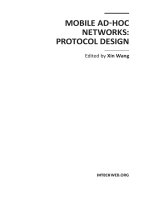Mobil Ad Hoc Networks Protocol Design Part 5 docx
Bạn đang xem bản rút gọn của tài liệu. Xem và tải ngay bản đầy đủ của tài liệu tại đây (877.58 KB, 40 trang )
Mobile Ad-Hoc Networks: Protocol Design
152
Fig. 12. Probability of correct packet reception for two users data transmission as a function
of distance, with and without coding
[133
8
, 171
8
] as specified, for instance, in the IEEE 802.11 standard. A 3/4 rate version of the
code is obtained by puncturing the coded bits. As you can deduce, the distance in which an
un-coded transmission becomes excessively error-prone varies as a function of the number
of used antennas. The cases with one transmitter and two transmitters show a maximum
reachable distance of about 125 and 100 meters respectively (when a single antenna is used)
which falls to roughly 75 and 25 meters respectively when the complete set of available
antennas are engaged in transmission. Where it has only one transmitter to full the capacity,
we have a greater advantage to encode the data flow with further rate instead of reducing
the number of antennas (even if we have more power to flow and earn diversity). This
means that in low traffic conditions, coding makes it possible to reach farther distances at
the price of an increased number of transmitting antennas. A MAC protocol should be able
to exploit this favorable condition by forcing users to change adaptively their coding and
antenna configuration, according to their own bit rate requirements and taking into account
the adjacent nodes’ status, which could be extrapolated from signaling packets. From above,
if a node requires that at least an average percentage of its data transmission is correctly
decoded, it may estimate (through RTS and CTS overhearing) how many its described
receiver is loaded, the appropriate curve which corresponds to the required performance
and distance to cover is selected from the graphs, hence it is necessary to establish the
proper coding and spatial multiplexing scheme that would allow transmission at the desired
successful probability, without overloading the receiver.
The information we get from this figure is that the coding cannot help anymore to reduce
the interference from other data flow, which we have introduced, when target is to reach
20 40 60 80 100 120 140 160 180 200
10
-1
10
0
distance
Pdecod
1 antenna R=1
2 antenna R=1
4 antenna R=1
6 antenna R=1
8 antenna R=1
4 antenna R=0.5
8 antenna R=0.5
4 antenna R=0.75
8 antenna R=0.75
Cross–Layer Design in Wireless Ad Hoc Networks with Multiple Antennas
153
farther distance. The system still has a very high performance even for a high number of
transmitting antennas, if the distance from the receiver is kept below 25m but when the
transmission distance increases, for seeing lesser interference it is better to send un-coded
packets over fewer antennas. In addition, we infer that it would be preferable for a MAC
protocol to split the longer packets into smaller units and transmit these units sequentially
by using fewer antennas, somehow, the system load does not increase. This last result
suggests that the use of channel coding (increasing the number of antennas) is not a very
good choice. The lower transmit power and the increased receiver load tend to cancel the
advantage which is introduced by the coding scheme. A similar problem would be found by
using for example space–time codes, refer to (Jafarkhani, 2005; Alamouti, 1998 & Paulraj,
2003). Hence, in the following design, we decide to assume that no stream is actually coded.
Our MAC protocol will focus on traffic control among adjacent nodes rather than bit rate
and coding scheme adaptation.
Fig. 13. shows the bit-rate transmission versus distance. It is important to note that in the
event of 2 users in transmission, the destination node is receiving data at double bit-rate in
case of a single user.
Fig. 13. Bit rate of data packets transmitted by 1 and 2 users by varying the distance
3. Cross layer MAC design for MIMO Ad Hoc networks
3.1 Introduction
The IEEE 802.11 protocol includes a specific mode called ad hoc. This mode operates
according to the so-called Distributed Coordination Function (DCF). In turn, DCF defines
two different modes, the basic mode (with random access after carrier sensing) and the
0 20 40 60 80 100 120 140 160 180 200
0
10
20
30
40
50
60
70
distance (m)
bit rate (Mb/s)
1 user
2 user
Mobile Ad-Hoc Networks: Protocol Design
154
collision avoidance mode (with four-way handshaking before channel access). We know
that preventing collisions would result in loss of data and waste of resource. In this section
we want to introduce a good solution for hidden terminal problem in ad hoc network. With
some channel knowledge, obtained through training sequences, receiver detects incoming
streams separately. Each node have a limited capability of
sequence simultaneously.
So the protocol must be aware of the tradeoff existing between the among of wanted data to
detect and the interference protection granted to this data. In other word, without enough
resources for interference cancellation, the receiver is not aware of interfering nodes nearby
and so it can not estimate their channel and cancel them. Indeed, instead of blocking
mechanisms, such as 802.11, we want to have simultaneous transmissions. We also want to
exploit the spatial demultiplexing capability of MIMO processing.
In our approach, we consider that channel of nodes with a certain distance from receiver can
be detected and cancelled and nodes with further distance and low received power can not
be cancelled. In Fig. 14. we show the probability of correct receiving a data packet in the
presence of interfering traffic versus the distance of the transmitter, for varying number of
antenna used by the transmitter. We see that with a 90% minimum success ratio, a
transmitter could reach 70m, 90m, 110m, using 8, 4 and 2 antennas respectively. It means
that the maximum number of antennas allowed when transmitting to a set of receivers
including corresponded neighbor. We use a framed communication structure, with four
phases. Theses phases are designed according to standard sequence of messages in a
collision avoidance mechanism, and are summarized as follows.
Fig. 14. Probability of correct receiving a data packet by varying the distance and number of
transmitter antennas
40 50 60 70 80 90 100 110 120 130 140
10
-1
10
0
probability
distance m
2 antenna
4 antenna
8 antenna
Cross–Layer Design in Wireless Ad Hoc Networks with Multiple Antennas
155
Sending RTS packet
: In this phase, all senders look into their backlog queue, and if it is not
empty they compose transmission requests and pack them into a single RTS message. Each
packet in the queue is split into multiple streams of fixed length, such that each stream can
be transmitted through one antenna. Any RTS has to specify the number of streams to be
sent simultaneously, in addition to the intended destination node. How to associate a
destination node with a suitable number of transmit antenna depends on the degree of
spatial multiplexing sought, as well as the local traffic intensity, thus the queue level of the
sender. Any RTS may contain several such requests. Moreover, an RTS is always sent with
one antenna and at full power. Each node selects number of antennas according to number
of streams of current packet and keeps free other antennas for sending other packets.
Sending CTS packet: During this phase, all nodes that were not transmitters, themselves
receive multiple simultaneous RTSs, and apply the reception algorithm of section 2 to
separate and decode them. CTSs are also sent out using one antenna and at full power. We
use 4 schemes for receiving data and interfering streams to control the number of allowed
transmitters and antennas.
Sending DATA packet: All transmitters receive CTSs and, after BLAST detection, they
follow CTS indication and send their streams.
Sending ACK packet: After detection, all receivers evaluate which streams have been
correctly received and send an ACK back to the transmitters. After the last phase the data
handshake exchange is complete, the current frame ends and the next is started.
A random backoff is needed for nodes that do not receive a CTS, as otherwise persistent
attempts may lead the system into deadlock. We make use a standard exponential backoff.
Accordingly, before transmitting, node wait for a random number of frames, uniformly
distributed in the interval
[1, ( )]BW i , where
i
tracks the current attempts, and
1
() 2 ,
i
BW i W
−
=
with W a fixed backoff window parameter refer to (IEEE 802.11 Standard,
2007).
3.2 RTS and CTS sending schemes
To specify our MAC protocol, we need to introduce a simpler protocol for comparison. The
definition of this protocol is necessary, since the approaches described in Section 2 can not
be directly compared to our solution, because of either the absence of a specific MAC
scheme refer to (chen and Gans, 2005), the optimization of MAC around some fixed PHY
parameters such as the number of antenna refer to (Vang and Tureli, 2005), the diverse issue
related to different modulation and signaling scheme refer to Hu and Zhang (2004), the
attention devoted to achieving full diversity instead of full parallelism refer to (Hu and
Zhang, 2004), or the idealized assumptions about a MIMO PHY level and MAC signaling
refer to (Sundaresan et al., 2004) This protocol is meant as an example of how a layered
networking solution would behave when set up on top of a SM-capable MIMO PHY level.
Furthermore, it is directly comparable with our policies, as it can into account the PHY used
(unlike (Sundaresan et al., 2004), that focuses on link capacity) and is sufficiently general not
to depend on the number of antenna per node (unlike (Vang and Tureli, 2005)). When a
node is granted access, it sends an RTS and waits for a CTS. With MIMO transmission,
packets are divided in streams, each 125-byte long. To increase bit rate, streams are split in
substreams, one per each available antenna and transmitted in parallel through all antenna.
If a packet is formed of a number of 125-byte streams and
=8, each antenna will send one
125-bit substream per stream. Ack’ed substreams remove from the queue of node and
Mobile Ad-Hoc Networks: Protocol Design
156
streams with errors are retransmitted. Indeed, Simpler protocol is a CSMA/CA protocol,
just using a more powerful MIMO PHY layer.
3.2.1 RTS sending scheme
Consider that the set of neighbors of a given node be denoted as
,
,…
. Let
be
the maximum number of antennas that s can uses when transmitting to any set of nodes that
includes
. Suppose that node is current node. At step 1, a request is created as
fellows. The node reads the
1 packet’s destination,
, and the number of unsent
streams,
. After that, node compares
with maximum antenna constraint,
. If
, the streams violate from maximum antenna constraint, hence forbidding any
further spatial multiplexing. The request pair
,
is inserted in the RTS packet.
If
, the pair
,
is inserted in the RTS. Each node keeps indices of all
packets selected for transmission in set
. The total number of antennas allocated until step
hold in . In the absence of interferes, node
could support
further
antenna. So, the node goes to step 2 and searches its queue , until it finds a packet
that
maximum number of destination’s antennas match the condition
1 . This means
that the
can stand the transmission of the 1 streams from other node, in addition to its
own. The transmitter sets
∪
, calculates the number of streams allocated to
packet
as 2 min
,
1,
, that not violate the maximum
number of antennas constraints
and 1 streams have been allocated. Then,
it inserts in the RTS packet the pair
,2, and finally updates 2 1 2. If
there is still antenna for transmission without saturating antenna constraints, algorithm goes
to next step and so on. In general, at step
, the node searches the queue for a packet
with
condition
1. Then
∪
,
1,
,
and
1 . The request
, is put in the RTS. The algorithm then
goes to step
1 if and only if
and a packet such that
is
found in the queue refer to (Casari et al., 2008). As an example consider Fig. 15. Another
example with further request could be found in Fig. 16. In Fig. 17. we show a pseudo code of
transmitter protocol.
Fig. 15. An example of application of RTS sending scheme.
Fig. 16. Another example of application of RTS sending scheme with further request
Cross–Layer Design in Wireless Ad Hoc Networks with Multiple Antennas
157
transmitter protocol
// Initialize the step index , the number of allocated antennas , the set of receivers and
the number of failures
1; 0 0;
;
0
// RTS phase: add users until class constraint are violated
While
1
// Is there a packet in the queue that complies with the current constraints?
if a packet
s.t.
1
// Add user as receiver
∪
// Determine number of streams to send that does not violate any current class
constraint
1,
1
Insert request
, in RTS
end if
end while
Send RTS
// Data phase: check CTS
if one or more CTS received then
Send data streams according to CTSs
1
else
Backoff for frames, uniformly distributed in
1, . 2
1
end if
if
ACK received then
Mark all ACK’ed streams
Remove from the queue all packets whose streams have been all ACK’ed
end if
Fig. 17. Pseudo code of transmitter protocol
3.2.2 CTS sending schemes
In this section we report 4 schemes for receiving data from transmitters. All of these schemes
contain two set
and . The first set contains all requests directed to the node that names
wanted request, the second set all other requests that names unwanted request. We knows
that if
streams implies to transmitted, the receiver estimates channel of this streams. After
that, number of available estimating resources is
. If
0 and exist any
request in the node queue, process will be continued in the next step and so on.
SNR based receiver protocol: The node grants first highest power request in and then
considers all other requests in
∪, re-ordered by decreasing received power. In Fig. 18.
we report a pseudo code of SNR based receiver protocol. In Fig. 19. an example of
application of this protocol is showed.
Mobile Ad-Hoc Networks: Protocol Design
158
SNR based receiver protocol
//Initialize number of trackable training sequences,
// CTS phase: apply CTS policy
if one or more RTSs received then
Create ordered sets
Let
be the ordered set with the indices of the packets in
Let
be the ordered set with the indices of the packets in
//Grant at least one wanted request
1
Read source
and number of data streams
for the packet with index
Insert grant
,
in CTS
// Manage other requests in order of decreasing received power
While
0&
do
Let be the request with the greatest power between
1 and
1
,
if
then
Insert grant
,
in the CTS
else
end if
end while
end if
Send CTS
//Data phase: receive data streams
if Data streams received then
De-multiplex streams and extract wanted ones
Send ACK for correctly received streams belonging to requests in
end if
Fig. 18. Pseudo code of SNR based receiver protocol
First wanted based receiver protocol: In this protocol, a node gives priority to wanted
transmission. If any estimating resources left , it then begins to consider unwanted requests.
In Fig. 20. we report a pseudo code of first wanted based receiver protocol. In Fig. 21. an
example of application of this protocol is showed.
Wanted based receiver protocol: In this case, the node grants the requests in and does
not consider
at all. In Fig. 22. we report a pseudo code of wanted based receiver protocol.
In Fig. 23. an example of application of this protocol is showed.
SNR based receiver protocol without interference cancellation: This scheme operates as
SNR based receiver protocol, but does not perform cancellation of interfering requests in
.
It means that only powerful interferes could be considered. In Fig. 24. we report a pseudo
code of SNR based receiver protocol without interference cancellation. In Fig. 25. an
example of application of this protocol is showed.
Cross–Layer Design in Wireless Ad Hoc Networks with Multiple Antennas
159
Fig. 19. An example of application of SNR based receiver protocol.
First wanted based receiver protocol
//Initialize number of trackable training sequences,
// CTS phase: apply CTS policy
if one or more RTSs received then
Create ordered sets
Let
be the ordered set with the indices of the packets in
Let
be the ordered set with the indices of the packets in
//Grant at least one wanted request
While
0&
do
1
,
Read source
and number of data streams
for the packet with index
Insert grant
,
in the CTS
end while
While
0&
do
1
,
end while
end if
Send CTS
//Data phase: receive data streams
if Data streams received then
De-multiplex streams and extract wanted ones
Send ACK for correctly received streams belonging to requests in
end if
Fig. 20. Pseudo code of first wanted based receiver protocol
Mobile Ad-Hoc Networks: Protocol Design
160
Fig. 21. An example of application of first wanted based receiver protocol.
Wanted based receiver protocol
//Initialize number of trackable training sequences,
// CTS phase: apply CTS policy
if one or more RTSs received then
Create ordered sets
Let
be the ordered set with the indices of the packets in
//Grant at least one wanted request
While
0&
do
1
Read source
and number of data streams
for the packet with index
,
Insert grant
,
in the CTS
end while
end if
Send CTS
//Data phase: receive data streams
if Data streams received then
De-multiplex streams and extract wanted ones
Send ACK for correctly received streams belonging to requests in
end if
Fig. 22. Pseudo code of wanted based receiver protocol.
Cross–Layer Design in Wireless Ad Hoc Networks with Multiple Antennas
161
Fig. 23. An example of application of wanted based receiver protocol.
SNR based receiver protocol without interference cancellation
//Initialize number of trackable training sequences,
// CTS phase: apply CTS policy
if one or more RTSs received then
Create ordered sets
Let
be the ordered set with the indices of the packets in
Let
be the ordered set with the indices of the packets in
//Grant at least one wanted request
1
Read source
and number of data streams
for the packet with index
Insert grant
,
in CTS
// Manage other requests in order of decreasing received power
While
0&
do
Let be the request with the greatest power between
1 and
1
,
if
then
Insert grant
,
in the CTS
end if
end while
end if
Send CTS
//Data phase: receive data streams
if Data streams received then
De-multiplex streams and extract wanted ones
Send ACK for correctly received streams belonging to requests in
end if
Fig. 24. Pseudo code of SNR based without interference cancellation receiver protocol.
Mobile Ad-Hoc Networks: Protocol Design
162
Fig. 25. An example of application of SNR based without interference cancellation receiver
protocol.
CTS sending schemes are the only way to reduce data traffic in ad hoc network, since
RTS/CTS are not used for channel reservation., but rather as an indication of intention
/clearance to transmit, also both RTS and CTS sending schemes favor the creation of
multiple point to point links, all potentially making use of SM. This is made possible by
inserting multiple requests (grants) in the RTS (CTS), each composed of multiple streams.
These schemes can operate on top of any PHY that successively detects multiple signals,
cancels their contribution from the received signal. We choose V-BLAST as one such PHY,
since it is a good representative and has recently received a lot of attention refer to (Zhang
and Lee, 2008).
3. Network simulation setup & results
For evaluating our MAC scheme, we deploy 25 nodes randomly in a square area with 8
antennas each and nearest neighbors 25 m apart. Traffic is generated according to a Poisson
process of rate
λ
packets per second per node. Each generated packet is made of k 125-
bytes long streams, with k randomly chosen in the set {1, 2, 3, and 4}. Unsent packets are
buffered. Each node has a finite FIFO queue where the packets are stored before being
served. We also study the effect of convolutional coding on data packets using the standard
802.11 code refer to (IEEE 802.11 standard, 2007), W and
max
BW
are 1 and 32 respectively.
For our simulation, we used the MATLAB.
Fig. 26. shows the average network throughput defined as a function of the offered traffic
λ
, defined as the number of correctly detected 125-byte streams per frame for all CTS sending
schemes. We see that wanted based receiver protocol has bad performance, because it
permits the sending of all requested streams and does not cancel any interferers. First
wanted based receiver protocol have better performance than wanted based, because it has a
way to cancel highest SNR interfering streams. Indeed, from network load 700, the amount
Cross–Layer Design in Wireless Ad Hoc Networks with Multiple Antennas
163
of requested traffic have not enough antenna for cancellation of unwanted signals and lead
to decrease in the throughput. In the worst case, one wanted request protected against
1 strongest interferences and lead to best performance of SNR based receiver
protocol.
Fig. 27. shows the average queue length as a function of the offered traffic
λ
for all CTS
sending schemes. We see that first wanted based protocol because of lower throughput at
network load larger than 800 does not allow sufficient packet sending. Also SNR based
protocol have shorter queue length. We observe that other protocol reach to upper bound of
delay. SNR based receiver protocol without interference cancellation has bad performance
because it hasn’t interference cancellation feature. Results show that the SNR based receiver
protocol reach to best performance , as it has high throughput and throughput ratio, limited
delay and queue length.
4. Conclusions
In this study, we combine MIMO multiuser detection at PHY layer with design of a protocol
at MAC layer in a cross layer fashion simultaneously to have a better throughput for mobile
ad hoc networks. As we can see in Fig. 26. this approach is able to support up to 12
Fig. 26. Network throughput versus network traffic.
Mobile Ad-Hoc Networks: Protocol Design
164
successful 125-byte streams per frame on average, which is larger than the maximum
number of antennas per node, i.e., 8. This is a very interesting result. It substantiates the
need for both a well-designed physical layer and a management protocol, and shows that
the number of terminal antenna is a soft limit in MIMO ad hoc networks, if the effective
rejection of multiple access interferences is provided. Also in Fig. 27 we show that average
queue length is shorter than maximum length of queue, i.e., 120. Future work on this topic
may be the extension to routing layer issues. Our scheme can be used on laptops that each
one is considered as an ad hoc node and uses 8 antennas with 3 cm distance between the
two adjacent antennas.
Fig. 27. Queue length versus network traffic.
5. References
Alamouti, S-M. (1998). A simple transmit diversity technique for wireless communication,
IEEE Trans Commun, 16., pp. 1451-58
Casari, P., Levorato, M. & Zorzi M. (2008). MAC/PHY Cross-Layer Design of MIMO Ad
Hoc Networks with Layered Multiuser Detection,
IEEE Transactions on Wireless
Communications
, 7. 11., pp. 4596-4607
Chen, B. & Gans, M. (2005). MIMO communication in ad hoc networks,
Proceeding of IEEE
VTC Conf
, Sweden, pp. 2434-38
Cross–Layer Design in Wireless Ad Hoc Networks with Multiple Antennas
165
Chen, H., Yu, F., Chan, H. & Leung, V. (2006). A novel multiple access scheme over multi-
packet reception channels for wireless multimedia networks,
IEEE Trans Wireless
Commun
, 6., pp. 1501-11
Choudhury, R-R., Yang, X., Ramantan, R. & Vaidya, N-H. (2006). On designing MAC
protocols for wireless networks using directional antennas,
IEEE Trans Mobile
Comput, 5. pp. 477-491
Gatsis, N., Ribeiro, A. & Giannakis, G. B. (2010) Optimal resource allocation in wireless
networks: algorithms and convergence,
IEEE Transactions on Wireless
Communications
, submitted.
Hu, M. & Zhang, J. (2004). MIMO ad hoc networks: medium access control, saturation
throughput, and optimal hop distance,
Journal of Commun Networks, pp. 317-30
IEEE Standards Department (2007), ANSI / IEEE Standard 802.11, IEEE Press
Jafarkhani, H. (2005).
Space-Time Coding: Theory and Practice, Cambridge University
Press
Madan, R., Cui, S., Lal, S. & Goldsmith, A. (2006). Cross layer design for lifetime
maximization in interference-limited wireless sensor networks,
IEEE Transactions
on Wireless Communications, 5. 11., pp. 3142-3152.
Park, M., Choi, S-H. & Nettles, S-M. (2005). Cross-layer MAC design for wireless networks
using MIMO,
Proceeding of IEEE Global Commun Conf, USA, pp. 938-942
Paularj, A., Nabar, R. & Gore, D. (2003). Introduction to Space-Time Wireless Communication,
Cambridge University Press
Paulraj, A-J., Gore, D-A., Nabar, R-U. & Boleskei, H. (2004). An overview of
MIMO communication: a key to gigabyte wireless,
Proceeding of IEEE, 92., pp. 198-
218
Ramantan, R., Redi, J., Santivanez, C., Viggins, D. & Polit S. (2005). Ad hoc networking with
directional antenna: a complete system solution,
IEEE J Selected Areas Commun, 23.,
pp. 496-506
Setton, E., Yoo, T., Zhu, X., Goldsmith, A. & Girod, B. (2005). Cross-layer design of adhoc
networks for real-time video streaming,
IEEE Trans Wireless Commun, 12., pp. 59-65
Sfar, S., Murch, R-H. & Letaief, K-B. (2003). Layered space-time multiuser detection over
wireless uplink systems,
IEEE Trans Wireless Commun, 2., pp. 653-668
Soleimani-Nasab, E. & Ardebilipour, M. (2009). Improve efficiency of ad hoc networks with
MIMO communication and cross
layer MAC design, Procceeding of IEEE ICACT
2009
, South Korea, pp. 907-912
Sundaresan, K., Sivakumar, R., Ingram, M. & Chang, T-Y. (2004). Medium Access Control in
ad-hoc networks with MIMO links: optimization consideration and algorithms,
IEEE Trans. Mobile Comput, 3., pp. 350-65
Vang, D. & Tureli, U. (2005). Cross layer design for broadband ad hoc networks with
MIMO-OFDM,
Proceeding of Signal processing Advances in Wireless Communication,
pp. 630-34
Zhang, J. & Lee, H-N. (2008). Throughput enhancement with a modified 802.11 MAC
protocol with multi-user detection support,
Int J Electronics Commun, 62., pp. 365-73
Mobile Ad-Hoc Networks: Protocol Design
166
Zorzi, M., Zeidler, J., Anderson, A., Rao, B., Proakis, J., Swindlehurst, A.L., James, M. &
Krishnamurthy, S. (2006). Cross-layer issues in MAC protocol design for MIMO ad
hoc networks,
IEEE Wireless Commun Mag, 13. 4., pp. 62-76
0
Performance Modeling of MAC and Multipath
Routing Interactions in Multi-hop Wireless
Networks
Xin Wang, J.J. Garcia-Luna-Aceves, Hamid R. Sadjadpour
University of California, Santa Cruz
USA
1. Introduction
For multi-hop wi reless networks, the performance experienced by each node is a complex
function of the following factors: 1). the signals used at the physical layer; 2). the radio
topology of the network; 3). the transmission scheduling established at the MAC layer, 4). the
route selection results of the network layer.
The input of any above component is partially decided by the output of the other components,
e.g. 1). transmission scheduling: radio topology decides whether links interfere with others, and
route selection decides which links will be used for transmissions; 2). route selection:theradio
topology of the network influences the route selection results directly; since routing control
packets are transmitted as the data packets at the MAC layer, the transmission scheduling
decides how the routing information is propagated throughout the network, etc.
Hence, analyzing the performance of protocol stacks in a wireless network must consider the
interactions between the different layers. In fact, a cross-layer perspective to both performance
analysis and protocol design brought to attention with recent advances in wireless networks.
It is critical for us to treat the entire protocol stack as a single al gorithmic construct in order
to improve the performance, and in general, it is not meaningful to speak about a MAC or a
routing protocol in isolation.
This chapter introduces a modeling framework for the characterization of the performance
attained with a MAC protocol working together wi th different packet forwarding
disciplines on top of a realistic physical layer. We also analyzed how different packet
forwarding disciplines interact with different channel access schemes to influence the system
performance.
2. R el at ed wo rk
A significant amount of work (e.g.,(Gitman, 1975; Tobagi, 1980a;b; Boorstyn et al., 1987;
Tobagi & Brazio, 1983; Shepard, 1996; Chhaya & Gupta, 1997; Wang & Garcia-Luna-Aceves,
2002; Wu & Varshney, 1999)) has been reported on the analytical modeling of
contention-based MAC protocols. However, there are very few prior works discussing
the interaction be tween MAC and packet forwarding in wireless networks, and most
of them are based on the discussion of simulation results focusing on contention-based
MAC p rotocols and s ingle-path routing. Das et al. (Das et al., 2000)(Das et al., 2001) use a
9
2 Theory and Applications of Ad Hoc Networks
simulation model to show that the interplay between routing and MAC protocols affects
the performance significantly in the context of AODV and DSR. Royer et al . (Royer et al.,
2000) explore the behavior of different unicast routing protocols when run over varying
contention-based MAC protocols. They find that table-driven routing protocols behave
in much the same way when used with different MAC protocols, while an on-demand
routing protocol is more sensitive to the functionality of the MAC protocol, because
it requires feedback mechanisms at the MAC layer. Barrett et al. (Barrett et al., 2003)
conducted a comprehensive simulation study to characterize the interaction between
MAC and routing protocols, node speed, and data rates in mobile ad-hoc networks.
They concluded that no combination of MAC and routing protocol was better t han o ther
combinations over all mobility models and response variables. Bai et al. (Bai et al., 2003)
proposed a framework consisting of various protocol-independent metrics to capture
interesting mobility characteristics, including spatial(temporal) dependence and geographic
restrictions. They observed that the mobility pattern influences the connectivity graph
that in turn influences the protocol performance. In addition, they did a preliminary
investigation of the common building blocks of MANET routing protocols, the effect of
mobility on these building blocks and how they influence the protocol as a whole. Vadde
et al. (Vadde & Syrotiuk, 2004) studied the impact o f QoS architectures, routing p rotocols,
and MAC protocols on service delivery in MANETs, using interaction graphs to visualize
the t wo-way i nteractions between factors. Vadde et al. (Vadde et al., 2006) used statistical
design of experiments to study the impact of factors and their interaction on the service
delivery in a MANET. They considered the factors of QoS architecture, routing protocols,
medium access control protocols, offered loads, and node mobility. Through statistical
analysis of the simulation results, they found that the MAC protocol and its interaction
with the routing protocol are the most significant factors influencing average delays, and
that throughput is not much impacted by the type of routing protocol used. The bulk of
the analytical modeling of wireless ad hoc networks has concentrated on the analysis of
MAC protocols in fully-connected segments of networks (e.g., satellite networks, cellular
networks, or single-hop wireless L ANs (WLANs)), because t hey are simpler to analyze than
multihop networks. The majority of this work has followed the formalism and assumptions
introduced by Abramson (Abramson, 1970; 1977) for the analysis of the ALOHA protocol,
and by Tobagi and Kleinrock (Kleinrock & Tobagi, 1975; Tobagi & Kleinrock, 1975) for
the analysis of the carrier sense multiple access (CSMA) protocol. The model t ypically
adopted assumes that all nodes have infinite buffers and tr ansmissions are scheduled
according to independent Poisson point processes. This implies that packets which were
either inhibited from being transmitted or were unsuccessfully transmitted are rescheduled
after a “sufficiently long” randomized time out to preserve the Poisson property (i.e.,
no correlation between new packet arrivals and their rescheduling). Packet lengths are
exponentially distributed and are independently generated at each transmission attempt
(including retransmissions). In many cases, acknowledgments are assumed to happen
instantaneously o r, in cases where propagation delay is taken into account, acknowledgment
traffic is simply ignored, and periods of collisions are restricted to the propagation time,
after which all other nodes are able to perceive any activity in the channel (through the
single-hop and perfect-channel assumptions). Regarding the quality of the radio links,
they are generally considered error free, and the event of unsuccessful transmission is
restricted to packet collisions at the receiver. Examples where such assumptions have
been made include (Roberts, 1975) (Kleinrock & Lam, 1975) (Colvin, 1983) (Lo & Mouftah,
168
Mobile Ad-Hoc Networks: Protocol Design
Performance Modeling of MAC and Multipath
Routing Interactions in Multi-hop Wireless Networks
3
1984) (Karn, 1990) (Barghavan et al., 1994), (Fullmer & Garcia-Luna-Aceves, 1995), and
(Fullmer & Garcia-Luna-Aceves, 1997).
Other works consider physical-layer aspects more explicitly within the context of single-hop
scenarios. Raychauduri (Raychauduri, 1981) analyzed slotted ALOHA with code division;
Gronemeyer and Davis (Davis & Gronemeyer, 1980) considered spread-spectrum slotted
ALOHA with capture due to time of arrival. Musser and Daigle (Musser & Daigle, 1982)
derived the throughput of pure ALOHA with code division. Pursley (Pursley, 1983)
studied the throughput of frequency-hopped spread-spectrum communications for packet
radio networks. In other cases, the error-free link assumption was relaxed and multipath
fading channels where considered while preserving other original assumptions (e.g., Poisson
scheduling). This is the case in the works by Arnbak and Blitterswijk, who studied
the capacity of s lotted ALOHA in Rayleigh-fading channels (Arnbak & Blitterswijk, 1987).
More recently, with the advent of the IEEE 802.11 standard for WLANs, its operation.
Unfortunately, the vast majority of this effort has considered only single-hop networks
under ideal channel conditions (Carvalho & Garcia-Luna-Aceves, 2003), (Bianchi, 2000),
(Cali et al., 2000), (Foh & Zukerman, 2002), (Kim & Hou, 2003). A gap still remains o n the
modeling of multi-hop wireless networks under specific combinations of MAC protocols and
packet-forwarding disciplines in a way that the impact of their interactions is taken into
account in the performance evaluation of each node.
3. Protocol interactions
In this section we address the interactions between protocol stacks and the classification
of different feedback information. The most important modeling factor in t he interaction
between the MAC layer and the physical l ayer is the probability that a frame transmission is
successful, because it is the basis for the scheduling of either transmissions or retransmissions
of frames by the MAC protocol. The output of any routing protocol is a subset of nodes
in the network, which forms a specific routing path, and this subset varies at different
stages of routing protocol. For example, when there is no existing route, the subset includes
every n odes that are involved in the route discovery (e.g. initiating route requests, sending
route replies o r forwarding routing control packets, etc.). After the route is established, the
subset consists o f the nodes that form a specific routing path or are responsible for the route
maintenance. In this paper, we focus on the interaction of routing and MAC protocols that
takes place after routes have been established. Accordingly, we are mainly interested on the
interaction between the MAC protocol and the number of next-hops per destination, which
are used according to specific forwarding rules. Our model captures this interplay by means of
the probability that a transmission schedule is collision-free. We classify the feedback information
that flows across layers into two classes: (a) Feedback information that does not depend on
the activity of other nodes (e.g., whether a node has data packets to send); and (b) feedback
information dependent on the activities of all other nodes (e.g., the successful transmission
probability of each frame, or the probability that a transmission schedule is collision-free).
The MAC and physical (PHY) layers are coupled with each other tightly at small time
scales encompassing just a few packet transmissions. On the other hand, route selections
are made b ased on the end-to-end information between the traffic source and destination;
hence, this activity interacts with the MAC layer at large time scales, i .e., hundreds of packet
transmissions. Based on the above considerations, we investigate the interaction between
protocol layers from small time scales (MAC and PHY) to large time scales (MAC and routing).
169
Performance Modeling of MAC and
Multipath Routing Interactions in Multi-hop Wireless Networks
4 Theory and Applications of Ad Hoc Networks
4. Model formulation
We assume that each node k transmits frames according to a transmission rate (transmission
probability) τ
k
, and retransmissions are independent of previous attempts. All nodes along
the selected routing path always have packets to send (i.e., the transmission queue of each
node is always nonempty). If there are more than one nodes transmit to the same receiver
simultaneously, the whole frame transmission is a failure.
4.1 Successful frame reception probability
Let P
r
k
denote the received signal power at node r for a signal transmitted by node k.
Let V denote the finite set of
|V| = n nodes spanning the network under consideration,
and V
r
⊆ V the subset of nodes that are in the reception range of node r. V
r
⊆ V
r
is
the subset of nodes that are on the selected routing path. V
r
incorporates the topology
information, while V
r
includes the feedback information from the network layer. At ti me t,
the signal-to-interference-plus-noise density ratio SINR
r
i
(t) for a signal transmitted by node i
and received at node r is (Tse & Hanly, 1999):
SINR
r
i
(t)=
P
r
i
(t)
∑
j∈V
r
χ
j
(t)P
r
j
(t)+σ
2
r
,(1)
where σ
2
r
is the background or thermal noise power at the front end of the receiver r. χ
j
(t) is
an on/off indicator,
χ
j
(t)=
1, if j transmits to r at time t,
0, otherwise.
(2)
χ
j
(t) reflects MAC layer transmission scheduling(contention) results. Let |V
r
| = n
r
,there
are exactly 2
n
r
−1
combinations of active transmitting nodes (interferers)inV
r
,excludingthe
transmitter i itself. In what follows, let
{c
r
ik
}
k=1, ,2
n
r
−1
denote the set of such combinations.
Additionally, c
r
i0
is the combination corresponding to the case when no interferers of r transmit.
Let γ
(c
r
i0
) denote the SINR at node r for a bit transmitted by i when none of r’s interferers
transmits:
γ
(c
r
i0
)=
P
r
i
L
i
σ
2
r
,(3)
where L
i
is the spreading gain (or bandwidth expansion factor) of the spread-spectrum
system. If K is the length of the frame in b its, and P
b
(γ) is the bit-error probability for a
certain SINR level γ, then the probability of successful frame reception ( f
(c
r
i0
)) when only the
sender transmits in the neighborhood of an intended receiver is:
f
(c
r
i0
)=
{
1 − P
b
[γ(c
r
i0
)]
}
K
.(4)
The probability q that a transmitted packet does not collide equals the probability that no
neighbor of the r eceiver transmits and the packet is received correctly (we do not consider the
partial overlapping case in this paper). The probability that no neighbor transmits equals
P
{no neighbor transmits} =
∏
j∈V
r
(1 − τ
j
) (5)
Hence, using conditional probability, q can be expressed as
q
= f (c
r
i0
)
∏
j∈V
r
(1 − τ
j
) (6)
170
Mobile Ad-Hoc Networks: Protocol Design
Performance Modeling of MAC and Multipath
Routing Interactions in Multi-hop Wireless Networks
5
We analyze the performance of the MAC layer following the approach introduced by
Carvalho et al. (Carvalho & Garcia-Luna-Aceves, 2004) and Bianchi’s model (Bianchi, 2000).
The MAC protocols we seek to model adjust their behavior dynamically according to the
feedback information of the PHY and n etwork layers to maximize the number of successful
transmissions. Accordingly, we approximate the operation of the MAC protocols by assuming
that these protocols in steady-state can be represented by a time-invariant function h
i
(·)
relating the successful transmission probability q
i
with the steady-state scheduling rate τ
i
,
τ
i
= h
i
(q
i
),i ∈ V,(7)
where the subscript i in the mapping function h
i
(·) denotes a node-specific instantiation of
the MAC protocol in use. Let
C
r
i
denote the random variable t hat indicates the occurrence of
a specific combination c
r
ik
of interferers. The probability that the set of active interferers is c
r
ik
,
i.e., P
{C
r
i
= c
r
ik
} is a function of the MAC-dependent transmission probabilities τ
i
,
P
{C
r
i
= c
r
ik
} =
∏
m∈c
r
ik
(1 − τ
m
)
∏
n∈c
r
ik
τ
n
,(8)
where
c
r
ik
denotes the complement set of c
r
ik
, V
r
−{c
r
ik
}. The probability q
i
that a frame
transmitted by i is successfully received can be obtained as follows by considering the set
{c
r
ik
}
k=1, ,2
n
r
−1
of all possible combinations of active nodes in V
r
:
q
i
= P{ successful frame reception }
=
∑
k
P{ successful frame reception, C
r
i
= c
r
ik
}
=
∑
k
P{ succ. frame reception|C
r
i
= c
r
ik
}P{C
r
i
= c
r
ik
}
=
∑
k
f (c
r
ik
)P{C
r
i
= c
r
ik
},(9)
Recall that c
r
i0
denotes the combinations corresponding to the case when no interferer of
receiver r transmit, i.e., c
r
i0
= {∅}, meaning that
c
r
i0
= V
r
, then we can approximate q
i
as
follows:
q
i
≈ f (c
r
i0
)P{C
r
i
= c
r
i0
} (10)
From Eq. (8),
q
i
= f (c
r
i0
)
∏
j∈V
r
(1 − τ
j
). (11)
After the linear approximation using the Taylor series expansion (justified in
(Carvalho & Garcia-Luna-Aceves, 2004)), we have
τ
i
= h
i
(q
i
) ≈ aq
i
,wherea = h
i
(0), (12)
From Eq. (12),
q
i
= f (c
r
i0
)
∏
j∈V
r
(1 − aq
j
). (13)
If we assume a
<< 1, and because 0 ≤ q
i
≤ 1, we can approximate the previous products a s
follows:
q
i
≈ f (c
r
i0
)
⎛
⎝
1
− a
∑
j∈V
r
q
j
⎞
⎠
(14)
From Eq. (12) and Eq. (14), we can obtain the functional form h
i
(q
i
) by which the MAC
layer relates the steady-state transmission probability τ
i
with the successful transmission
probability q
i
.
171
Performance Modeling of MAC and
Multipath Routing Interactions in Multi-hop Wireless Networks
6 Theory and Applications of Ad Hoc Networks
4.2 End-to-end throughput
Given that all nodes along an active path are assumed to be saturated, the average MAC layer
one-hop throughput for any node i carrying traffic is
S
i
=
E{Data Payload}
T
i
. (15)
where
T
i
is the average service time of node i. WenotethatsinceT
i
varies across different
nodes due to the topology information and traffic distributions, S
i
is per-node throughput.
We denote the end-to-end throughput as
S
E
=
h
j
min
k=1
{S
1
,S
2
, ,S
k
, ,S
h
j
} (16)
where h
j
is the hop length of path j, S
k
is the average one-hop throughput of hop k,definedin
Eq. (15).
4.3 Interaction with number and type of paths
Multipath routing protocols ad apt different constraints for the establishment of next hops to
destinations. The existing multipath routing protocols can be classified according to the t ype
of paths they use:
1. Node-disjoint paths (Ye et al., 2003), which are paths to a destination in which a node
appears in at most one path.
2. Link-disjoint paths (Marina & Das, 2001) (Nasipuri et al., 2001), which are paths to a
destination in which the same pair of nodes defining a link can appear in at most one
path.
3. Minimum-cost paths (Lee & Gerla, 2001), which are paths to a destination that have the
minimum cost amongst all available paths. These paths need not be link or node disjoint.
Because there is no standard definition of minimum-cost for multipath routing p rotocols, we
focus on the study of node-disjoint routing and link-disjoint routing. We use Dijkstra’s
shortest path algorithm to form the multipath routing set. We choose h op-count as the
routing distance metric. The first selected path is the one with the shortest distance between
the source and the destination. A path wi ll be added to the selected routing set if: 1). it
has the shortest distance among all the unselected paths; 2). it satisfies the node-disjoint
or link-disjoint constraint with previous selected paths. If there are more than one path
with the same distance, we will select the p ath with the smaller IP address. We continue
this process until no more paths can be added. In our modeling framework, the routing
information is fed into V
r
, c
r
ik
and S
f
E
, separately. We extend the definition of interference
matrix (Carvalho & Garcia-Luna-Aceves, 2004) to take into account the effect of routing
factors. As indicated in Eq. 11, in order to calculate q
i
, we need to know the set of interferers
for each transmitter-receiver pair. We select a node as a potential interferer if and only if: (a)
The received interference signal power at the receiver is above the carrier sensing threshold, as
indicated in (Carvalho & Garcia-Luna-Aceves, 2004); and (b) it is on at least one of the routing
paths.
172
Mobile Ad-Hoc Networks: Protocol Design
Performance Modeling of MAC and Multipath
Routing Interactions in Multi-hop Wireless Networks
7
4.4 Interaction with packet forwarding disciplines
Once routing paths are formed, nodes use different forwarding rules to select their successors.
Opportunistic routing protocols (Biswas & Morris, 2005) (Chachulski et al., 2007) have been
proposed to exploit the benefits of cooperative diversity and path diversity techniques. To
simplify our analysis, we classify the different routing forwarding rules into the following
types:
1. Single-copy forwarding: A node selects its neighbor with the smallest distance to the
destination as the successor, and the smallest address is chosen if there are multiple
successors with the same distance.
2. Multiple-copy forwarding: A node selects all successors for forwarding to a destination.
3. P-persistent opportunistic forwarding: A node selects a given successor to forward a packet
towards a destination with a probability p
f
.
As in Section 4.3, the routing forwarding rule impacts the calculation of SINR
r
i
(t), c
r
ik
and
q
i
, which influences the conditional probability of successful frame reception ( f (c
r
i0
))andthe
mapping function h
i
(. ).
5. Modeling contention-based MAC: 802.11 DCF
In this Section, we extend the prior model proposed by Carvalho et al. and Bianchi’s model to
study t he interactions between 802.11 DCF and different packet forwarding methods. Given
the backoff time characterization i n 802.11 DCF, the average service time is
T = T
B
+ T
S
,where
T
B
is the average backoff time, T
S
is the average time to successfully transmit a packet at
the end of the backoff operation. In order to obtain
T
B
, T
S
, w e first need to calculate the
probability that a transmission is successful (p
i
s
), the probability that the channel is idle (p
i
i
),
and the probability that a collision occurs (p
i
c
). The transmission probability τ
i
of each node i
is
τ
i
=
2[1 − 2(1 − q
i
)]
[1 − 2(1 − q
i
)](W
min
+ 1)+(1 − q
i
)W
min
(1 − (1 − q
i
)
m
)
(17)
where W
min
is the minimum contention window s ize specified f or the backoff operation, m
is the standard-defined maximum power used to set up the maximum contention window
size, i.e., W
max
= 2
m
W
min
. Eq. (17) gives us the functional form h
i
(q
i
) by which the MAC
layer relates the steady-state transmission probability τ
i
with the successful transmission
probability q
i
. Then we could derive a first order approximation for it using Taylor series
expansion and express τ
i
in terms of q
i
τ
i
(q
i
)=
2W
min
(W
min
+ 1)
2
q
i
, (18)
when we consider all nodes in the topology, can be rewritten in the matrix notation τ
= aq,
where τ
τ
τ
=[τ
1
τ
2
τ
n
]
T
, a = 2W
min
/(W
min
+ 1)
2
,andq =[q
1
q
2
q
n
]
T
. The probability
that there exists some node from V
r
transmitting a frame while node i is in backoff is
p
i
tr
= 1 −
∏
j∈V
r
(1 − τ
j
) (19)
The probability p
i
suc
that a transmission is successful is the probability that some node in
V
r
transmits successfully, conditioned on the fact that at least one node in S
i
attempted to
173
Performance Modeling of MAC and
Multipath Routing Interactions in Multi-hop Wireless Networks
8 Theory and Applications of Ad Hoc Networks
transmits, i.e.,
p
i
suc
=
∑
k∈S
i
P{k succeed |k transmits}P{k transmits}
p
i
tr
=
∑
k∈S
i
q
k
τ
k
p
i
tr
(20)
Then, according to Bianchi’s model, the probability that a transmission is successful is
p
i
s
= p
i
tr
p
i
suc
; the probability that the channel is idle is p
i
i
= 1 − p
i
tr
, and the probability that
a collision occurs is p
i
c
= p
i
tr
(1 − p
i
suc
).WecanfurtherderiveT
B
and T
S
using p
i
s
, p
i
i
and p
i
c
.
6. Modeling schedule-based MAC: NAMA
We choose NAMA as an example of schedule-based MAC schemes, because it completely
eliminates the communication overheads of building the dynamic channel access schedule,
except for collecting two-hop neighbor information, which is minimal compared with the
task of collecting complete network topology information. In NAMA, a hash function is
implemented at each node. The hash function takes a distinctive string of a node as input,
and derives a random priority for each neighbor within two hops. T he distinctive input string
is the concatenation of the corresponding node identifier (collected through periodical HELLO
messages) and the current time slot number such that the priority changes in different time
slot. The channel access eligibility of each node is then determined by the node comparing its
own priority with those of its two-hop neighbors. If a node has the highest priority, the node
can access the channel within the corresponding time slot, while its two-hop neighbors are
forbidden from channel access because they have lower priorities than the no de. In order to
find the correlation between the steady-state MAC layer scheduling rate (τ
i
) and the successful
transmission probability q
i
, we first define the probability that the transmission schedule for
node i is collision-free (φ
i
) as follows:
φ
i
= P
{no conf licts|success in fo}
P
success inf o
(21)
where P
success inf o
is the probability that the topology information exchange is successful
in i’s two-hop range. P
{no conf licts|success in fo}
is the conditional probability of conflict-free
scheduling given the correct neighbor information. For simplicity, We assume that the
unsuccessful information exchange leads to transmission collisions. Then
τ
i
= φ
i
q
i
(22)
The time frame of NAMA can be further divided into a signal section and a data section. We
denote the length of a time frame as
T
f
= N
signal
t
signal
+ N
data
t
data
, (23)
where t
signal
, t
data
are the signal and data slot length; N
signal
, N
data
are the number of signal
and data slots, respectively.
Then according to Equation 6,
P
success info
= f (c
r
i0
)P{no neighbor transmits} (24)
In NAMA, each node randomly picks up a signal slot in the signal section to exchange
topology information.
174
Mobile Ad-Hoc Networks: Protocol Design
Performance Modeling of MAC and Multipath
Routing Interactions in Multi-hop Wireless Networks
9
P{no neighbor transmits} =(1 −
1
N
signal
)
N
i
2
−1
(25)
where N
i
2
is the number of neighbors within two hops of i. The conditional probability of
node i winning the node election given the correct topology information is:
p
i
s
=
1
N
i
2
(26)
Because NAMA uses the node identifier and the current time slot number as input to derive a
random priority for every neighbor, which is unique within two hops, it eliminates the conflict
scheduling given the correct topology information.
P
{no conf licts|success in fo}
= 1 (27)
φ
i
= p
i
s
P
success inf o
(28)
From Eq. ( 22) (24) (25) (28), we can obtain the correlation between τ
i
and q
i
. Given that the
average number of times node i could transmit successfully in one time frame is
τ
i
N
data
,the
average service time is
T =
T
f
τ
i
N
data
(29)
7. Model validation
802.11 DCF MAC NAMA MAC PHY
W
min
15 t
sign a l
(μs) 142 Transmission rate (Mbps) 54
W
max
1023 N
sign a l
500 Transmission Power (dBm) 16
RTS (bytes) 30 t
data
(μs) 362.2 Sensitivity of PHY (dBm) -69
CTS (bytes) 24 N
data
1000 Path loss factor (α) 4
ACK (bytes) 24 Transmission range (m) 79.58
MAC Header (bytes) 34 Temperature (Kelvin) 290
Slot Time (μsec) 9 Noise Factor 10
SIFS (μsec) 16
Table 1. Simulation Parameters
7.1 Simulation settings
We compare the numerical r esults with the simulation results obtained from
Qualnet (Qualnet Simulator, n.d.). The detailed simulation settings can be found in
Table I. The packet length used is 1500 bytes. The duration of the simulation is 100 seconds.
For the system throughput results, the simulations are repeated with ten different seeds to
average the results for each scenario. We validate the numerical results against simulation
experiments under two scenarios. The first scenario consists of 50 nodes distributed randomly
across a 500
× 500 square meters area. The second scenario consists of 100 nodes distributed
across a 800
× 800 square-meter area. The only constraint for the topology generation is that
the network needs to be connected. For each topology, we set up multiple multi-hop CBR
flows and vary the number of CBR flows to investigate the influence of packet forwarding
methods.
175
Performance Modeling of MAC and
Multipath Routing Interactions in Multi-hop Wireless Networks









